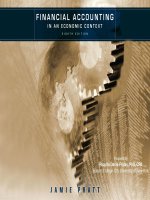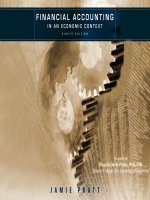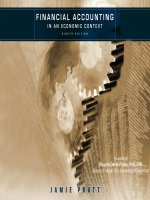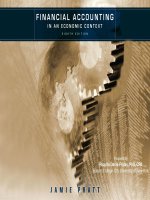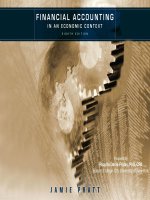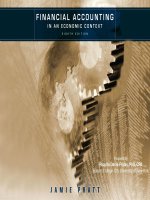Test bank for financial accounting in an economic context 9th edition
Bạn đang xem bản rút gọn của tài liệu. Xem và tải ngay bản đầy đủ của tài liệu tại đây (82.49 KB, 16 trang )
Test Bank for Financial Accounting in an Economic
Context 9th Edition
Free Text Questions
What is the account, Accounts Payable, used for?
Answer Given
Accounts payable represents the amount of money a company expects to pays its
vendors. The payables arise from the purchase of supplies from vendors/suppliers.
Autry Company determined its total sales were $400,000, salaries
expense was $110,000, dividends paid were $8,000, rent
expense was $14,000, other operating expenses were
$20,000, and customers still owed $2,000 at the end of the
year. How much is net income for the year?
Answer Given
$400,000 – $110,000 – $14,000 – $20,000 = $256,000
Explain the difference between net income and cash flow from
operations.
Answer Given
Net income, reported on the income statement, consists of revenues and expenses or
more general asset and liability inflows and outflows, that may not necessarily include
cash. Cash flows from operations, reported on the statement of cash flows, include only
the cash inflows and outflows.
A company sold 10 widgets. How will the amounts the company
reports as ‘Sales’ differ from amounts reported as ‘Cost of
Goods Sold’?
Answer Given
The amount reported as sales represents the dollar amount for which the widgets were
sold to the customers. Cost of goods sold represents the original cost paid by the
company to acquire the inventory item. The difference between the dollar amount of
sales and the dollar amount of cost of goods sold represents gross profit for the
company.
Which assets on a company's balance sheet have no physical
substance? Explain.
Answer Given
Intangible assets have no physical substance. They are reported as long-term assets on
the balance sheet and represent the legal right to produce and sell certain products.
Like other assets, they represent a potential future benefit for the company.
Why would a company use a notes receivable account?
Answer Given
A notes receivable account arises because companies accept notes in exchange for a
sale with extended credit terms. Notes represent amounts that customers or employees
have agreed to repay. Notes typically have an interest component.
Explain the concept of liquidity.
Answer Given
Liquidity is a representation of how close an asset is to cash. Assets are listed in order
of liquidity on the balance sheet, with the most liquid assets first. Since cash is the most
liquid asset, it is presented as the first item in the asset section of the balance sheet.
Describe how the amount of net income relates to the balance
sheet.
Answer Given
The balance sheet reports an item called retained earnings that represents an
accumulation of all the profits earned by the company since operations began, less all
the dividends paid out to shareholders. Net income for the current period is added and
dividends declared are subtracted from the beginning retained earnings amount to
determine the ending balance of retained earnings, which in turn is reported on the
balance sheet.
Which group of financial statement users would be most
concerned with the amount of a company’s total current
assets and current liabilities?
Answer Given
Creditors, such as bankers in other lenders, would be very interested in the liquidity of a
company. Comparing the amount of current assets with current liabilities is a common
analysis tool used by those interested in liquidity. If a company has more current
liabilities than current assets, it is possible the company will not be able to pay its
current bills when they come due.
Distinguish between the amounts reported on the income
statement compared to the amounts reported on the
statement of cash flows.
Answer Given
Amounts reported on the income statement are revenues and expenses. These
amounts reflect general asset and liability inflows and outflows. The amounts reported
on the statement of cash flows include only the cash received and the cash paid out.
Where in a company’s financial statements would you locate the
‘book value’ of the company?
Answer Given
The dollar amount reported as total shareholders’ equity represents the net book value
of the company. Shareholders’ equity is found on the balance sheet. To calculate the
book value, subtract liabilities from assets.
Describe operating activities.
Answer Given
Operating activities involve the sale of goods and services and the related cost of
providing the goods and services. These activities produce additional capital that can be
reinvested in producing assets, used to pay debt, or distributed to the owners in the
form of dividends.
If cash inflows from operating activities were $2,000, cash
outflows for financing activities were $2,500, and the net
increase in cash was $4,000, how much are cash flows
from investing activities?
Answer Given
$4,000 – (-$2,500) - $2,000 = $4,500
What is unique about the way plant and equipment appear on the
balance sheet?
Answer Given
Plant and equipment includes the actual costs of acquiring assets such as warehouses,
office buildings, equipment, machinery, vehicles, etc. In the balance sheet, total
accumulated depreciation is shown as a deduction from the cost of the plant and
equipment. The balance in the accumulated depreciation account represents the total
cost of the plant and equipment that has been transferred to the income statement
(expensed) as it represented an allocation of the cost used up that related to past
accounting periods.
What type of assets are included in short-term investments?
Answer Given
Short-term investments include stock, bonds, and similar investments. Generally these
securities are readily marketable and are intended by management to be sold within a
short period of time, usually less than one year.
Which business activity occurs first for a business? Why does
this business activity occur first?
Answer Given
Financing activities typically occur first in a business. A business must acquire cash or
other operating capital before any investments can be made.
Describe how the equity sections of balance sheets differ for
each of the three types of business entities.
Answer Given
The shareholders’ equity section of the balance sheet for corporations consists of two
components—contributed capital and retained earnings. Partnerships have one capital
account for each owner in the owners’ equity section of the balance sheet. A
proprietorship has only one capital account. Neither a partnership nor a proprietorship
has a retained earnings account.
What business aspect does the statement of shareholders’
equity measure?
Answer Given
The statement of shareholders’ equity measures changes in 1) the contributed capital
accounts, representing the value of owners’ investments in the business, and in 2) the
retained earnings account, which measures the extent to which the business reinvests
its earnings and pays dividends.
Give an example of a prepaid expense. Why would a company
use this account?
Answer Given
Prepaid expenses may include items such as prepaid rent, prepaid insurance, and other
amounts of which payment must be made up front.
What concerns might you have if you examined a company's
balance sheet and found a negative amount in retained
earnings?
Answer Given
A negative amount in retained earnings is common for young companies because it
often takes several years to become profitable. Retained earnings may also decline and
produce a negative balance (if allowed under the respective state laws) if a company
pays large dividends. If the dollar amount in retained earnings is negative because of
continual losses, there should be a cause for concern.
Which asset is more liquid, inventory or accounts receivable?
Why?
Answer Given
Since amounts in the Accounts Receivable account represent inventory that is already
sold, this account will generate cash more quickly than inventory that has not yet been
sold. Therefore, accounts receivable is more liquid than inventory.
What business aspect does the income statement measure?
Answer Given
The income statement measures operating performance over a particular period.
Multiple Choice Questions
Below are several accounts from Norel Company’s accounting
records: Total assets, end of year $110,000; Total liabilities,
end of year 36,000; Contributed capital, end of year 12,000;
Retained earnings, beginning of year 18,000; Dividends for
the period 31,000; Net income 75,000. The amount of
retained earnings at the end of the year is:
1.
a. $34,000.
2.
b. $40,000.
3.
c. $62,000.
4.
d. $64,000.
Property, plant and equipment may include which of the
following?
1.
a. Intangible assets and land.
2.
b. Inventory and equipment.
3.
c. Buildings and cash.
4.
d. Land and office buildings.
Which account is associated with the sale of inventory?
1.
a. Cost of goods sold.
2.
b. Depreciation.
3.
c. Inventory expense.
4.
d. Equipment.
Seuss Company determined its total sales were $500,000,
salaries expense was $210,000, dividends paid were
$15,000, rent expense was $25,000, other operating
expenses were $13,000, and customers still owed $4,000 at
the end of the year. How much is net income for the year?
1.
a. $267,000.
2.
b. $252,000.
3.
c. $263,000.
4.
d. $530,000.
Cash reported on a company’s balance sheet represents
1.
a. the profit a company made during the current year.
2.
b. the amount the President of the Company has in his or her personal account.
3.
c. the amount collected from customers during the current year less the amount paid for
expenses.
4.
d. the currency a company has access to at the balance sheet date.
Which one of the following is not an asset?
1.
a. A company’s equity in the common stock of another company.
2.
b. A company’s trademarked name for a process.
3.
c. Retained earnings.
4.
d. Notes receivable.
Valley Company has cash, current liabilities, and long-term
liabilities of $120,000, $30,000, and $31,000, respectively.
Valley has no current assets other than cash. How much
cash can Valley use to acquire equipment so that amount
of current assets is double the amount of current
liabilities?
1.
a. $30,000
2.
b. $60,000
3.
c. $15,000
4.
d. $90,000
Which one of the following is considered an operating activity?
1.
a. Payment to a vendor for supplies.
2.
b. Purchase of company trucks for cash.
3.
c. Payment of dividends to shareholders.
4.
d. Issuing stock to investors.
Which one of the following is an asset?
1.
a. A patent of a company’s secret formula for reverse osmosis.
2.
b. Retained earnings.
3.
c. Notes payable.
4.
d. Accounts payable.
On the balance sheet, a company should report the cost of
intangible assets:
1.
a. in the current assets section.
2.
b. as an amount owed to shareholders.
3.
c. as an amount that is estimated by the CFO.
4.
d. at acquired cost less any accumulated amortization.
Which one of the following equations represents retained
earnings activity for a year?
1.
a. Beginning balance + expenses – dividends = ending balance.
2.
b. Beginning balance + cash receipts – cash payments = ending balance.
3.
c. Beginning balance + dividends – net income = ending balance.
4.
d. Beginning balance + net income – dividends = ending balance.
Which one of the following groups of accounts contains only
liabilities?
1.
a. Accounts payable, retained earnings, notes payable.
2.
b. Supplies expense, cost of goods sold, interest expense.
3.
c. Wages payable, mortgage payable, taxes payable.
4.
d. Contributed capital, accounts payable, retained earnings.
Which one of the following groups of accounts contains only
assets?
1.
a. Contributed capital, retained earnings, revenues.
2.
b. Cash, contributed capital, retained earnings.
3.
c. Prepaid expenses, land, accounts receivable.
4.
d. Building, equipment, depreciation expense.
The major accounting difference between interest expenses for
creditors and dividends declared and paid to shareholders
is that interest expenses:
1.
a. decrease retained earnings and dividends increase retained earnings.
2.
b. impact cash flows, while dividends do not.
3.
c. are not on the income statement while dividends declared and paid are.
4.
d. are on the income statement and dividends declared and paid are not.
The amount reported on a company’s balance sheet as retained
earnings is the same as the amount reported on the
company’s:
1.
a. income statement as net income.
2.
b. statement of shareholders’ equity as beginning retained earnings.
3.
c. statement of cash flows as cash received from operating activities.
4.
d. statement of shareholders’ equity as ending retained earnings.
Which expense is associated with the use of patents?
1.
a. Interest.
2.
b. Amortization.
3.
c. Cost of goods sold.
4.
d. Depreciation.
Which one of the following statements is true?
1.
a. A company’s own stock is its most liquid asset.
2.
b. Profits are normally kept in a company’s retained earnings until distributed as
dividends.
3.
c. Long-term investments will be used to pay current liabilities.
4.
d. Current assets have no physical substance.
Which one of the following is a liability?
1.
a. Interest receivable.
2.
b. Contributed capital.
3.
c. Retained earnings.
4.
d. Wages payable.
At the end of 2014, Campbell Company has total assets and
liabilities at $42,000 and $11,000, respectively. Campbell
reported net income for 2015 in the amount of $12,000.
How much is shareholders’ equity at the end of 2015?
1.
a. $30,000
2.
b. $22,000
3.
c. $31,000
4.
d. $43,000
Which one of the following appears on the income statement?
1.
a. Inventory.
2.
b. Retained earnings.
3.
c. Dividends.
4.
d. Interest revenue.
Desert Company has retained earnings of $11,000, total assets
totaling $41,000, and total liabilities of $20,000. How much
is total shareholders’ equity?
1.
a. $8,000
2.
b. $19,000
3.
c. $21,000
4.
d. $27,000
Which account is associated with borrowing money?
1.
a. Interest expense.
2.
b. Goodwill.
3.
c. Cost of goods sold.
4.
d. Depreciation.
If the beginning and ending balances in retained earnings are
$15,000 and $10,000, respectively, and dividends during
the year are $8,000, then net income for the year is:
1.
a. $10,000.
2.
b. $3,000.
3.
c. $18,000.
4.
d. $32,000.
Why are liabilities separated into current and long-term?
1.
a. Users want to know which amounts will be paid using current assets.
2.
b. Because current and long-term classifications are just common sense.
3.
c. This format helps a company determine how much profit was made.
4.
d. The SEC requires companies to do so.
Current assets are:
1.
a. all assets except inventory.
2.
b. all assets that provide benefits extending beyond one year.
3.
c. cash, accounts receivable, and buildings.
4.
d. all assets that are expected to be converted to cash in the near future.
Which one of the following creates a decrease in retained
earnings?
1.
a. Prepaid assets.
2.
b. Equipment.
3.
c. Dividends.
4.
d. Merchandise inventory not sold.
Favre Company has current assets, shareholders’ equity, current
liabilities, and long-term liabilities of $10,000, $27,000,
$4,000, and $8,000, respectively. How much are long-term
assets?
1.
a. $12,000
2.
b. $29,000
3.
c. $32,000
4.
d. $46,000
On which financial statements will you find a company’s financial
position at a specific point in time?
1.
a. All financial statements combined.
2.
b. Income statement and balance sheet.
3.
c. Balance sheet and statement of shareholders’ equity.
4.
d. Balance sheet only.
Long-term investments can include all of the following except:
1.
a. notes receivable maturing in nine months.
2.
b. equity securities of another company to be held for more than a year.
3.
c. ten-year debt securities of another company.
4.
d. land to be held beyond one year.
Which one of the following groups of accounts contains only
current assets?
1.
a. Inventory, accounts receivable, equipment.
2.
b. Cash, equipment, copyrights.
3.
c. Cash, accounts receivable, merchandise inventory.
4.
d. Patents, copyrights, and trademarks.
The amount a company expects to collect from its customers is:
1.
a. accounts receivable.
2.
b. short-term equity securities.
3.
c. inventory.
4.
d. accounts payable.
Which expense is associated with long-term assets?
1.
a. Dividends.
2.
b. Depreciation.
3.
c. Cost of goods sold.
4.
d. Interest.
Most investors believe that the statement of cash flows is
1.
a. a useful source of information regarding the cash flow of an entity.
2.
b. the only statement in an annual report whose results correlates to stock price value.
3.
c. too complicated.
4.
d. a useful measure of a company’s profit.
A partnership and a corporation differ in that:
1.
a. a partnership is a legal entity, while a corporation is not.
2.
b. the equity sections of partnership and corporation balance sheets report different
items.
3.
c. partnerships always have more cash than corporations.
4.
d. a corporation has an income statement and a partnership does not.
Your bank loaned ten million dollars to Hamilton Stores to
finance the construction of a manufacturing plant. In which
section of Hamilton’s statement of cash flows would you
be able to determine whether the company used the cash
to build the new plant?
1.
a. Operating activities
2.
b. Owner activities
3.
c. Financing activities
4.
d. Investing activities
Smith Corp. earned $300,000 profit during 2015. On which
financial statement(s) will the exact dollar amount of the
profit be clearly stated?
1.
a. Statement of shareholders’ equity and income statement.
2.
b. Income statement only.
3.
c. Balance sheet and income statement.
4.
d. Statement of shareholders’ equity, income statement, and the balance sheet.
Kelly Company has total assets, liabilities, and shareholders’
equity of $32,000, $17,000, and $15,000, respectively at the
beginning of 2015. If Kelly reports revenues of $130,000,
expenses of $80,000, and pays dividends of $30,000, how
much is shareholders’ equity at the end of 2015?
1.
a. $35,000
2.
b. $53,000
3.
c. $44,000
4.
d. Not enough information to determine.
Sanchez Corporation has total assets, current liabilities, and
long-term liabilities of $40,000, $2,000, and $13,000,
respectively. If Sanchez purchases equipment for $5,000
for cash, how much would shareholders’ equity be?
1.
a. $25,000
2.
b. $10,000
3.
c. $29,000
4.
d. $11,000
Given below are several accounts from Caterpillar Company’s
accounting records: Cash $ 15,000; Accumulated
depreciation 7,000; Retained earnings, beginning of year
22,000; Contributed capital 25,000; Patents 2,000;
Dividends 5,000. Net income for the year was $40,000. How
much is total shareholders’ equity at the end of the year?
1.
a. $86,000.
2.
b. $88,000.
3.
c. $87,000.
4.
d. $82,000.
Which one of the following groups of accounts contains only
assets?
1.
a. Equipment, patents, accounts receivable.
2.
b. Accounts receivable, building, retained earnings.
3.
c. Accounts payable, notes payable, contributed capital.
4.
d. Retained earnings, goodwill, and accounts payable.
The acquisition of equity and debt financing is considered:
1.
a. a financing activity.
2.
b. net income.
3.
c. an investing activity.
4.
d. an operating activity.
The most common revenue account is:
1.
a. cash.
2.
b. sales.
3.
c. shareholders’ equity.
4.
d. liabilities.
Intangible assets are:
1.
a. goodwill, patents, copyrights, and trademarks.
2.
b. property, plant, and equipment.
3.
c. all assets except current assets.
4.
d. those assets that an owner can purchase with cash only.
As used in accounting, “notes” may be reported:
1.
a. only as company debt offerings.
2.
b. only as assets on the balance sheet.
3.
c. as either assets or liabilities.
4.
d. on the income statement or the balance sheet.
When an entrepreneur wishes to start a business, capital must
be attracted in the form of:
1.
a. net income.
2.
b. cost of goods sold.
3.
c. operating activities.
4.
d. equity or debt financing.
